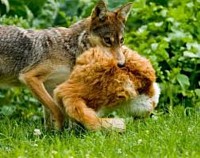DNR Information
DNR Information on Coyotes
Coyote Problems Northwest Indiana
Dealing with Nuisance Coyotes
Coyotes were rare or uncommon in Indiana until the early 1970s. They have since adapted to the Hoosier landscape and are present throughout the state, including urban areas.
General Characteristics
The coyote is slightly smaller than a standard collie dog in size and is similar in shape. It has a long slender snout, pointed ears and comparatively long legs. The upper body is grizzled gray or buff, with a reddish brown or gray muzzle. The lower body is white, cream-colored or reddish yellow. The coyote has a bushy tail, which it carries below the level of its back. Weights average 30 lbs (range from 20 to 50 pounds), and they measure 40 to 50 inches in length from nose to tail tip. Coyotes are elusive and normally avoid humans. They can be active any time of day or night, but are observed more typically at dawn and dusk. The coyote communicates by barking, yelping and howling. Coyotes will develop a “search image” for a prey type that is more easily scavenged or killed. A “search image” includes visual, auditory and olfactory senses.
Reproduction
Coyotes may pair up for life. They mate in February, and a litter of 5 to 10 pups is born in a den during April. The den is often located in a bank or on a hillside, or it may be an enlarged woodchuck or rabbit burrow. When the pups are old enough to take solid food, they are fed by both parents, who provide instruction on how to hunt until the fall months, when the youngsters are nearly full grown and ready for life on their own. Coyotes usually hunt as singles or pairs and may travel extensively to secure food.
Food
Coyotes are opportunistic foragers that will consume anything of nutritional value. Coyotes primarily feed on small mammals, even in urban environments, but they will not turn down an easy meal, nor will they pass up a free meal of artificial food sources. They will scavenge exposed garbage or other refuse, and may even kill and consume house cats and small dogs.
Prevention and Control
Feed pets indoors whenever possible; pick up leftovers if feeding outdoors and store pet and livestock feed where it’s inaccessible to wildlifeEliminate water bowls and other artificial water sources (if possible).Position bird feeders in a location that is less likely to attract small animals or bring the feeders in at night (to keep coyotes from feeding on the bird food or the other animals).Do not discard edible garbage where coyotes can get to it. Secure garbage containersTrim and clean shrubbery near ground level to reduce hiding cover for coyotes or their preyDo not allow pets to run free and provide secure nighttime housing for themIf you start seeing coyotes around your home, discourage them by shouting, making loud noises or throwing rocks but NEVER corner a coyote – always give the coyote a free escape route.
Farmers with livestock can take additional precautions, such as:
Use net-wire or electric fencing to keep coyotes away from livestockShorten the length of calving or lambing seasonsConfine livestock in a coyote-proof corral at nightUse lights above corralUse strobe lights and sirens to scare away coyotesRemove dead livestock promptly so coyotes won’t be able to scavengeUse guard animals, such as dogs, donkeys and llamas to protect livestock
Landowners, or a person with written permission from a landowner, may take coyotes year-round on private property by snaring, trapping or shooting without a permit from the DNR. A landowner does not need a permit to take coyotes on his/her property by one of these methods, but a hunting or trapping license is required to hunt or trap coyotes on land other than your own.
Call, Text or Email Larry
Ph 219-928-6024
nwidetectors@gmail.com


